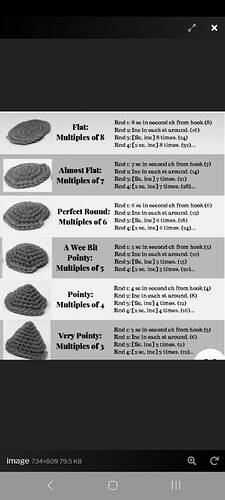Hi all! I was wondering if i could maybe get some tips on how to make patterns, thank yall :))
Oo fun! So basically once you know how to make basic shapes and use simple techniques, you can make almost anything! For example, you can implement increases and decrease to make certain shapes. For a cat, you could have a circle for the head, oval body, half circles or bobbles for arms, and triangles for ears. Lots of designers like to look at inspiration pictures and base their creation off of that. Others just go with the flow, freehand it, and write the pattern down as they go. Honestly, it’s just whatever technique works best for you, it may take some time to figure it out, but you’ll get it eventually and it’s gonna be worth it!
Tysm! I will definitely use this advice!
I’ve been writing amigurumi patterns on Ribblr for almost two years now, here’s some tips I have:
- With amigurumi, make sure your lines make sense. You could write them in this format
1: 6sc in mr (6)
2: inc× 6 (12)
3: [sc, inc] ×6 (18)
4-6: sc ×18 (18)
As an example on how to lay it out!! The numbers in the brakcets (-) shows the stitch count. The instructions in-between the square brackets [-] show what you would repeat, then the number outside the brackets ‘×6’ shows you how many times to repeat! - If you’re making a complicated pattern, it helps to have reference pictures!
- It’s always useful to say when to stuff too, and when + where to put safety eyes!!
- Your testers will help you spot any spelling errors and give suggestions + advice on how to make it easier to understand when/if you come to posting a tester call!! All of the testers I’ve worked with have been super friendly and I hope the same for you!!
Goodluck with writing your own patterns, I can’t wait to see what you come up with!! I’d love to help if you have any specific questions!
Tysm! I will definitely come back and ask if i need help!
of course!!! that’s great <3
To add on Bubblez, you want to make sure your style is consistent, but you may also wanna keep in mind that, if you have a set of stitches in the same stitch, you’ll need a marker for that. So you’ve got the (#) in their example as the stitch count and the [#, #] as instructions to be repeated, keep in mind you’ve also got the fancy brackets {#} and other ways to mark seperations.
You can start by observing others patterns to understand how it works and then I like to get inspo like say I wanna make a whale, I like to free crochet my pattern while writing it down as I go changing things I want as I go. And then I make more to test them, or get testers off ribblr ofc : ) hope this helps! If you need anything else you can dm me!
Ive been making my own patrerns for about 4 or 5 years! I’d be happy to help!
first, this will be helpful:
-look at other people’s patterns! notice how they make different shapes!
-practice!
-dont be afraid to frog!
- dont be afraid to use refernces either!
making your own patterns is so fun, i cant wait to see what you create (:
Thanks to everyone to has replied so far! Its been super helpful
Whatever you design make sure it is unique. Don’t use copyrighted or trademarked characters or images. At all
It should be your own original work and ideas
No Pokémon, no Mickey Mouse, no Nintendo characters, Hello Kitty or anything like that
Also search the help center on how to set up and use a shop.
I would definitely research and compile notes from pattern editors. Pattern writing has proper format. I’ve been designing for a few years myself and still learning. The other day I learned this. Take the the out…. So to explain
It I’ll use it in the context the editor mentioned.
Ch 18 and start in second ch from hook. Making one sc in each ch for a total of 17 sc.
the word the adds confusion whereas eliminating it the instructions are direct.
Proper bracket usage
Knowing Gauge
Stitch counts
List of tools your using
Sentence structure
Lots of photos
Stitch notes
Finished size
Amount of yarn usage
Make your patterns as professional as possible.
I’m probably missing some key items but these come to mind.
Have fun ![]()
As has been said by others, you might apply for a couple tests to see how others do patterns and get a flat base. Once you have an idea how you want to build your patterns, start with something simple that you want to make, like a sea creature. Round ones are a good place to start. (A lot of people do turtles or octopi/jellyfish.)
Once you’re ready to really get wet about it, design something you love, and something you want to make. Passion projects drive your desire to finish, so it’s a good way to keep yourself invested. And write down… everything! Even if you’re not at a computer, if you’re working on or thinking about a project, take notes in a composition notebook or a notepad file on your phone or something.

